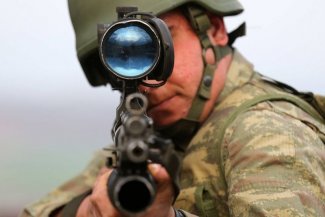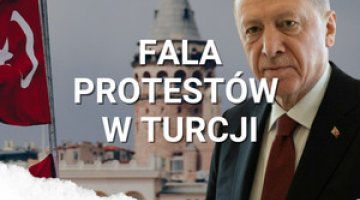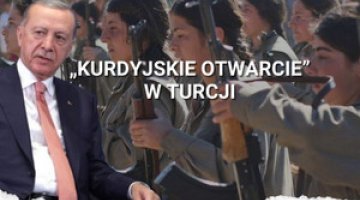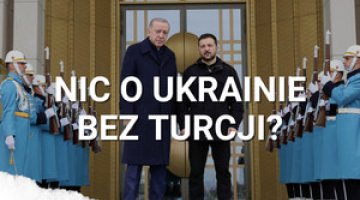Turkey invades the Kurdish para-state in Syria

On 9 October the Turkish president Recep Tayyip Erdoğan announced the launch of a military operation in northern Syria, the declared aims of which are to create a security zone separating Turkey from the areas controlled by Syrian Kurds, and then to relocate Syrian refugees in Turkey to that area. During the first few hours of the operation, Turkish forces conducted at least 181 aerial and artillery attacks on Kurdish targets, and also began a limited ground assault on the western section of the planned zone.
The Turkish operation has received harsh international criticism, including from the EU, most European countries, Iran, the Arab states, as well as the Kurdistan Region in Iraq. It was also criticised by the US, although President Donald Trump’s expression of his ‘understanding’ of the operation on 6 October is regarded as a catalyst for Ankara’s action. More restrained criticism came from NATO, of which Turkey is a member. Russia expressed its understanding of Turkey’s actions, although it also stressed the need to respect Syria’s territorial integrity and keep civilian losses to a minimum. Five European countries (including Poland) have requested a meeting of the UN Security Council in connection with the crisis.
Commentary
- The declared aim of Turkey’s operation is to occupy a strip of around 30 km of Syrian territory along the whole of its border with Turkey. These areas are mostly inhabited by Kurds, and since 2011 they have been controlled by structures of the Party of Democratic Union (PYD) and its armed wing, the People’s Self-Defence Units (YPG). The latter is associated with the extreme left-wing and de facto pro-independence Kurdistan Workers’ Party (PKK), which has been designated a terrorist organisation by both the EU and the US. During the Syrian civil war, the PYD created a para-state structure, the so-called Autonomous Administration of North and East Syria, in the areas they control now and the ethnic Arab territories they captured in battles with the self-proclaimed Islamic State. This area covers almost a third of the territory of Syria, and is inhabited by at least 2 million people. The state has an efficient administration and its own armed forces (the Syrian Democratic Forces, SDF), the core of which remains the YPG. During the war with Islamic State (since 2015), the SDF was the US’s main ally, although it essentially maintained neutrality towards the Assad regime.
- From Ankara’s perspective, the PKK (and the PYD identified with it) has been one of the most serious threats to the security and integrity of the Turkish state since the 1980s. The PKK aroused the separatist aspirations of Turkey’s Kurds (who make up around a quarter of its population), and can still conduct insurgent and terrorist activities on Turkish territory to varying degrees of intensity. For Ankara, the para-state structures in Syria created by the PYD/PKK, the role of the Kurds in the Syrian conflict, the de facto recognition of their agency by the countries involved in the conflict (mainly the US), and their links with the PKK’s Turkish centre (the PYD’s leadership are Turkish citizens) seriously threaten the destabilisation and disintegration of the state. Turkey has consistently sought to isolate, marginalise and eliminate the Kurdish para-state structures in Syria. Previous attempts to achieve this goal included a series of military operations in Syria: Euphrates Shield (2016), which prevented the integration of the Kurdish areas in northern Syria; Olive Branch, which eliminated the Kurdish exclave of Afrin in northwest Syria (2018), and finally the pressure to create a buffer zone with the rest of the Kurdish-controlled areas along the border. Although at present Turkey’s goal is only to take over a relatively narrow strip along the border, its real aim is the elimination of the Kurdish para-state: to occupy the Kurdish territories and major administrative centres; weaken the authority of the Kurdish government, and get the Arabs belonging to the para-state’s structures to renounce their service to it; and eliminate the political potential which has been the Kurds’ bargaining chip both in the Syrian conflict and internationally.
- An important factor pushing Turkey to act is the Syrian refugee problem, which has been growing there in recent years (there are around 3.6 million on Turkish territory at present), generating serious social and political tensions: growing public aversion to their presence is considered to be the main cause of the spectacular failure of Turkey’s ruling AKP in the elections to the mayoralty of Istanbul in June. On the one hand, the authorities in Ankara have been pushing the EU to increase its financial assistance, while on the other they have put forward the idea that the refugees should return to a specially-created security zone within Syria. This project is intended to rebuild public confidence in the authorities, justify the military intervention, and finally to radically change the ethnic structure on the border between Turkey and Syria at the expense of the Kurdish population. This rhetoric met with very limited interest in the EU, and the start of the present military campaign has led to harsh criticism of the idea.
- The catalyst for the current operation was Trump’s alleged consent to it, as granted in a telephone conversation with Erdoğan on 6 October. The US president apparently expressed his ‘understanding’ of the operation, and in the following days he announced the complete withdrawal of US forces from Syria (there are currently around 1000 soldiers cooperating with the SDF) and the transfer of responsibility for the Turkey region to the Middle East countries and the EU. Although on consecutive days Trump, US officials and commentators have criticised or toned down the decision, or even denied it was taken, Ankara has treated it as binding. Misunderstandings over the Kurdish question (such as the different levels of American cooperation with the Iraqi, Syrian and Iranian Kurds) had been the most serious problem in US/Turkey relations from 1990 until now, and the US’s military cooperation with the SDF (which has served as the US’s sole and de facto most important partner in Syria) was seen as an openly anti-Turkish action.
- Both the force of Turkey’s convictions and previous experience suggest that the conflict in northern Syria will take an extreme turn. Turkey’s military potential, which has been built up in the theatre of operations for months, its technological advantage, the use of the pro-Turkish Syrian opposition in combat (thus minimising Turkey’s own losses) all give it an enormous advantage over the forces of the SDF (which nominally numbers up to 100,000 fighters). As during the previous operation, bombardment and artillery fire on the SDF’s principal positions in Afrin has been observed, as well as attempts to cause panic among the civilian population, and the targeting of areas dominated by Arabs (the vicinity of Tal Abjad, Manbij et al.). In the current military context – in contrast to the Syrian Kurds’ defence of Kobane in 2014, but similar to the case of Afrin (as well as the Iraqi forces’ attack on Kirkuk in Iraqi Kurdistan in 2017) – the relatively rapid disintegration and collapse of the Kurdish structures in northern Syria cannot be ruled out. This may cause a humanitarian tragedy and the exodus of the civilian population, and in a wider perspective, a thorough revision of the balance of forces in the Syrian conflict, although this means that a complete elimination of the Syrian Kurds as a player in the region seems unlikely.
- At the current stage of the conflict, both Turkey and the Kurds seem to be isolated. The weakening of the Kurds is in the interests of the regime in Damascus, and also of Russia and Iran. However, it is very much not in the interests of Damascus and Iran to see the elimination of the Kurds, the strengthening of Turkey in Syria and the return to their country of millions of opposition-minded Syrian refugees (a current change in Syria’s religious structure at the expense of Sunni Arabs is a strategic achievement for and a pillar of the power of Bashar al-Assad). Despite Moscow’s relative understanding of the Turkish operation, its objective remains to maintain as much pressure as possible on every actor in the conflict, including Turkey. In this situation, one strategically important factor is the situation around Idlib in north-western Syria, a territory of about 3 million civilians wherein the radical Islamic opposition is centred, and whose capture is now the main goal of Damascus and its protectors. The collapse of Idlib would inevitably lead to a mass exodus onto Turkish territory and destabilise that country. The attitude of Washington remains unclear. Although it has been inconsistent, the US is motivated by a distrust of Turkey and irritation at its activities; a sense of debt to the Kurds; sensitivity to the public mood; and finally a fear of completely losing any influence over how the situation in Syria develops. Depending on what happens next, these factors will play a key role in slowing the progress of Turkey’s military operation and the political gains it hopes to achieve. The situation Turkey has provoked will be a catalyst for a profound general re-evaluation of the Syrian theatre of operations, and on the international stage more broadly.
- For Turkey, the operation in Syria is the most serious step towards a radical reinforcement of its international position, irrespective of its allies’ attitude. Although the chances of achieving a military success in Syria and temporarily weakening the Kurdish threat are great, a total solution to either the Kurdish question or the problem of the Syrian refugees in Turkey is unlikely. In addition, Ankara now runs the risk of getting entangled in a new phase of the conflict; a radical deterioration in its relations with the West (both the US and the EU); and finally, it risks being outplayed by Russia. In the most unfavourable outcome, Turkey’s domestic problems could get much worse: economically (under pressure from the West), socially (including the refugee issue), and finally regarding security (especially if the Idlib situation deteriorates).
- From the Western perspective, the current situation poses a strategic challenge. Turkey’s policy is not appreciated by the ruling elites, still less by the general public. The risk of a new phase of the migration crisis, which Ankara has openly threatened, is a very serious problem: it will only grow, although it is unlikely that Turkey will open up its territory to Kurdish refugees at the expense of its own interests. An additional challenge is the problem of Islamic State; the Kurds had been detaining its prisoners of war, who could now find themselves at liberty again.
- The disputes over Turkey’s offensive in Syria are part of a set of tensions which had already existed between Turkey and the West. In the case of the EU, these include disputes about the Cypriot gas deposits and issues of democratisation; and in the case of the US, the entire scope of the two countries’ political and military cooperation, including Turkey’s purchase of Russian S-400 air defence systems. Each of these cases has already led to the threat or the limited implementation of economic sanctions against Turkey. Therefore, it is likely that the Turkish operation in Syria will contribute to the breakdown of existing partnerships with the West, and also risks reinforcing the illusion within the EU that Russia could be a major player and a desirable partner in the Middle East.




